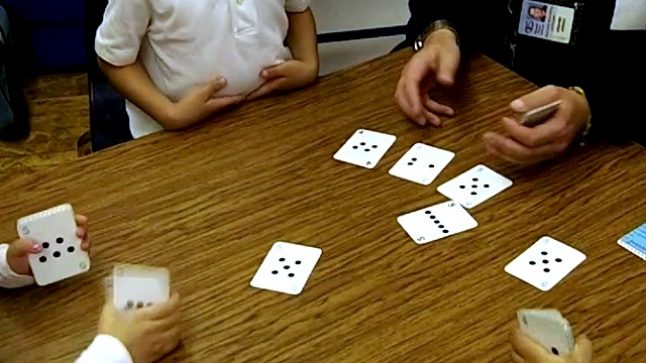Series: Ideas at Work
Down with Naked Numbers

All kinds of confusion can result when children are asked to rattle off the numbers from 1 to 10 or 20 or higher without actually counting something. In our learning labs and activities we are working to help teachers find ways to avoid “Naked Numbers” and to help children understand that quantity is an attribute, not a noun.
One of our research lessons on number arrangements gives children opportunities to develop visual number sense of quantity and to build subitizing skills (the ability to rapidly and accurately quantify a set of items without counting). The children find many different ways to arrange three popsicle sticks. As they look at their own and other children’s creations, they develop a sense of “three-ness” and the different ways it can be constructed (composed and decomposed).
In turn, teachers themselves have found many ways to give children the repeated experiences they need to solidify their understanding of number.
Program participant David Newman at Chappell Elementary finds it easy to give his preschool children plenty of experience with comparing the value of numbers by having them play a simplified version of the classic card game “War.” The pack of cards he uses only have two suits, stars and dots. While a few cards use the number symbols, most arrange the dots and stars in configurations similar to those found on dice so that the game reinforces subitizing and visual number sense. Appropriately for prekindergarten, the numbers only go up to 6.
Mr. Newman finds it important to introduce educational math games for kids by modeling. Playing a few rounds with a child while others watch is all that is needed. All cards are distributed face down between the two players. Each player turns up one and the higher number takes both cards. If the same number is turned up, the one marked with a star wins. Otherwise, the winner of the next round takes the cards. Mr. Newman notes that this game is a great way to introduce children to playing a game with rules without adult supervision. He noticed that the game also helps with fine motor skills as the children learn to handle cards and keep them in piles.
My card looks like one, two and if I turn it this way it looks like two, one. So it could go here or there.
Another program participant, Melinda Chum, and her kindergarteners at Bridge School enjoyed creating a Three Museum after doing number arrangements with craft sticks. Later after reading 10 Black Dots by Donald Crews one child suggested, “We could use the dots to make the Three Museum like we did with the sticks.” Ms. Chum put this idea into action.
She invited small groups of children to join her as she brought out a basket of black dots and 3” x 5” index cards. She then modeled how many different ways she could arrange the dots. She labeled one card with a 1-1-1 pattern as she said, “I put one here, one here, and one here.” She went on to demonstrate 1-2 and 2-1 patterns that put two closer together and one further away. The children went on to create their own patterns by sticking their three black dots on the white index cards.
Ms. Chum really understands how important it is for children to think and talk about what they are doing in order to deepen their understanding. So once they completed their patterns, she asked them to place their cards under the labeled number pattern cards and explain why it fit where they put it.
She reports, “It was wonderful to see how they think and decide that their card could belong just about anywhere on the number pattern graph depending on how you turn the card and how you are looking at it. During center time, they continued to think and rearrange their cards, commenting on things like ‘My card looks like one, two and if I turn it this way it looks like two, one. So it could go here or there.”
That rich conversation gave Ms. Chum clear evidence that her children really understood the Big Idea that pictures and objects can be arranged in different ways and that no matter which way they arrange their three-dots-card, there would still be three dots.